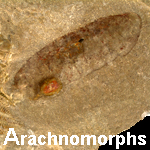Arachnomorphs
 Some of the strangest looking Cambrian arthropods are grouped with the arachnomorphs, a group that includes extinct forms such as trilobites and eurypterids and modern groups such as spiders, ticks, and horseshoe crabs.
Some of the strangest looking Cambrian arthropods are grouped with the arachnomorphs, a group that includes extinct forms such as trilobites and eurypterids and modern groups such as spiders, ticks, and horseshoe crabs.
Understanding the evolutionary relationships of Cambrian arachomorphs to one another, as well as resolving paleobiogeographic patterns within the group, has been a major focus of research by paleontologists at the University of Kansas in recent years. For more details on this research, please click here to go to the Evolution and Paleobiogeography webpage.
Below we provide a gallery of some of the non-trilobite arachnomorph fossils that have been discovered in Utah. These include fossils of the following species:
- Dicranocaris guntherorum Briggs and Lieberman et al., 2008
- Nettapezoura basilika Briggs and Lieberman et al., 2008
- Emeraldella sp. Walcott, 1912
- Leanchoilia superlata Walcott, 1912
- Leanchoilia? cf. protogonia Simonetta, 1970
- Mollisonia symmetrica Walcott, 1912
- Sidneyia sp. Walcott, 1911a
- Utahcaris orion Conway Morris & Robison, 1988
- Beckwithia typa Resser, 1931
In addition to these non-trilobite arthropods, we also present the first known specimen of the common trilobite species Elrathia kingii (Meek, 1870) that shows traces of the thoracic appendages.
Gallery of Arachnomorphs
Note: Marks on all scale bars are centimeters (cm) unless indicated otherwise.
Dicranocaris guntherorum Briggs & Lieberman et al., 2008

University of Utah (UU) 06011.03 (Holotype). Wheeler Formation, Drum Mountains, Millard County, Utah. Figure 5.1 in Briggs and Lieberman et al. (2008).

KUMIP 135148 (Paratype). Wheeler Formation, House Range, Millard County, Utah. Figure 5.4 in Briggs and Lieberman et al. (2008).

KUMIP 314079 (Paratype; Part, counterpart). Wheeler Formation, House Range, Millard County, Utah. Figure 5.6 in Briggs and Lieberman et al. (2008).
Nettapezoura basilika Briggs and Lieberman et al., 2008

Emeraldella sp. Walcott, 1912

Leanchoilia superlata Walcott, 1912

KUMIP 204783 (Part, counterpart). Spence Shale Member of the Langston Formation, Wellsville Mountains, Box Elder County, Utah. Figured as "Unknown Arthopod 1" by Conway Morris & Robison (1988; fig. 23.1a, 23.1b).

KUMIP 314028 (Part, counterpart). Spence Shale Member of the Langston Formation, Wellsville Mountains, Box Elder County, Utah. Figure 7.1 in Briggs and Lieberman et al. (2008).

KUMIP 314029. Spence Shale Member of the Langston Formation, Wellsville Mountains, Box Elder County, Utah. Figure 7.2 in Briggs and Lieberman et al. (2008).

KUMIP 314030. Spence Shale Member of the Langston Formation, Wellsville Mountains, Box Elder County, Utah.

KUMIP 314031. Spence Shale Member of the Langston Formation, Wellsville Mountains, Box Elder County, Utah. Figure 7.3 in Briggs and Lieberman et al. (2008).
Leanchoilia? cf. protogonia Simonetta, 1970

Mollisonia symmetrica Walcott, 1912

KUMIP 314041. Spence Shale Member of the Langston Formation, Wellsville Mountains, Box Elder County, Utah. Figure 9.3 in Briggs and Lieberman et al. (2008).

University of Utah (UU) 06011.04. Wheeler Formation, Drum Mountains, Millard County, Utah. Figure 9.1 in Briggs and Lieberman et al. (2008).
Sidneyia sp. Walcott, 1911a

KUMIP 204798. Wheeler Formation, House Range, Millard County, Utah. Figure 14.4 in Briggs and Robison (1984).

KUMIP 204799. Wheeler Formation, House Range, Millard County, Utah. Figure 14.1 in Briggs and Robison (1984).

KUMIP 314033. Spence Shale Member of the Langston Formation, Wellsville Mountains, Box Elder County, Utah. Figure 6 in Briggs and Lieberman et al. (2008).
Utahcaris orion Conway Morris & Robison, 1984

KUMIP 204784. Spence Shale Member of the Langston Formation, Wellsville Mountains, Box Elder County, Utah. Figure 21.1a, 21.1b in Conway Morris & Robison (1988)

KUMIP 204785. Spence Shale Member of the Langston Formation, Wellsville Mountains, Box Elder County, Utah. Figure 21.2 in Conway Morris & Robison (1988).
Beckwithia typa Resser, 1931

Elrathia kingii (Meek, 1870)
